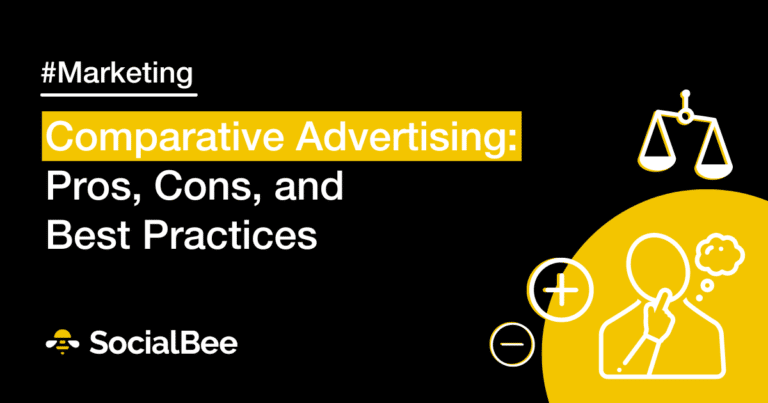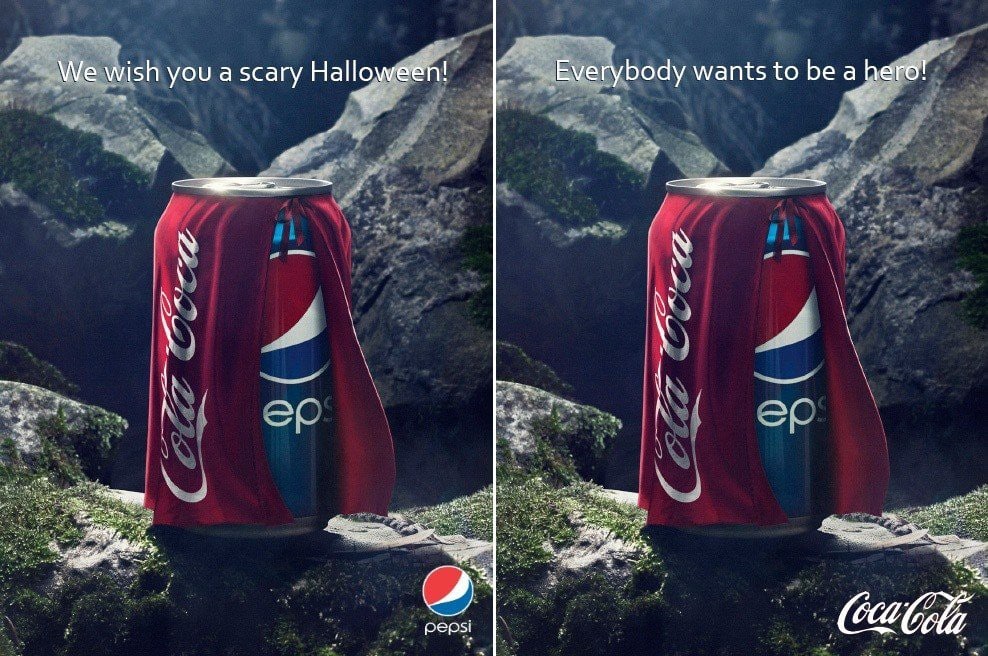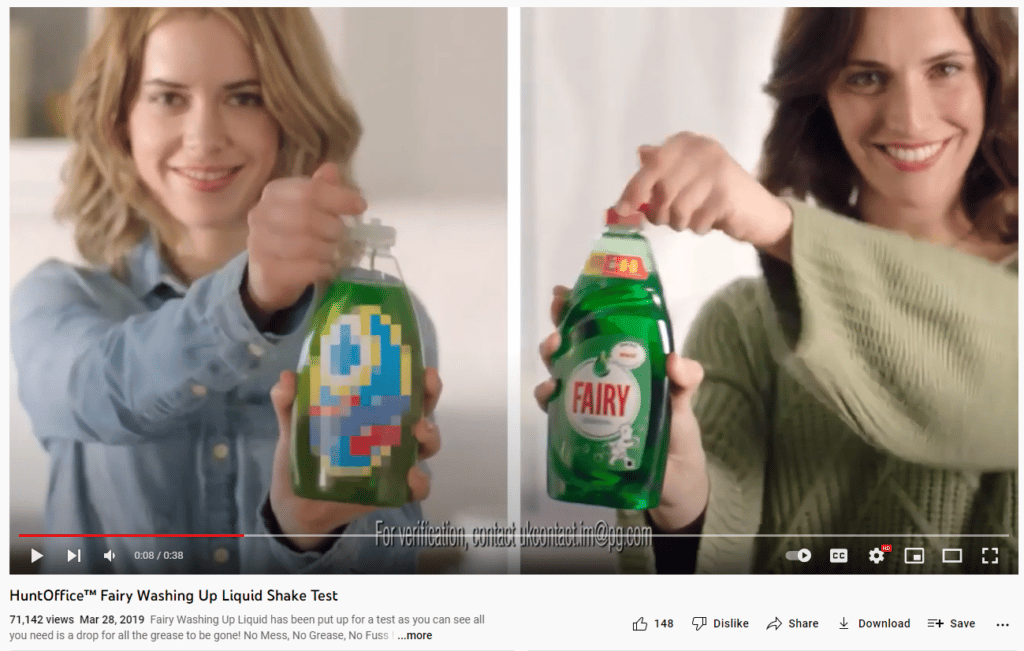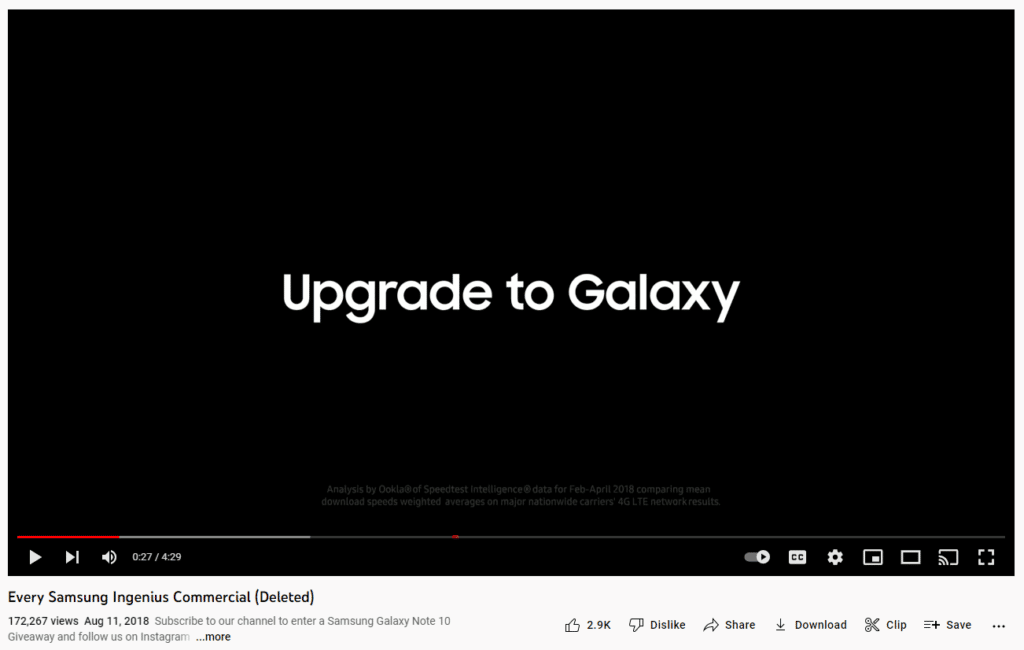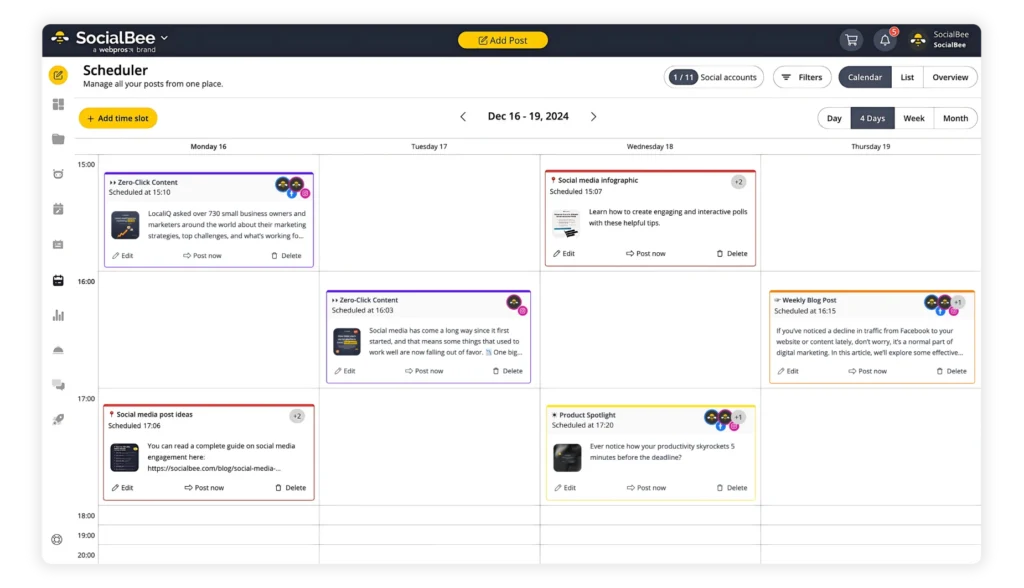
Content Writer
Are you looking to differentiate your brand through comparative advertising? Then you must learn how to approach it the right way.
Like any other competition, there is a price to be earned—an increase in customers.
Of course, the big marketing prize doesn’t have to limit itself just to more sales. Businesses can also compete for market share, brand exposure, social media followers, new subscribers, and many other things.
If you’re ready to try a bolder marketing technique, then let’s see how competitive advertising works and if this technique is the one for you.
We’re SocialBee LABS SRL, part of WebPros. We use the information you provide to share relevant content and product updates, as outlined in our Privacy Policy. You can opt out anytime.

What Is Comparative Advertising?
Comparative advertising, also known as combative advertising, is a type of advertising in which a business compares its products or services to a competitor’s.
Like with many other advertising methods, the goal is to show your product’s value through comparative advertisements. But by using comparative advertising, you’re comparing two products, one of which is yours, to show potential customers that your product performs better.
Probably the most prominent and well-known case of comparative advertising is the Pepsi & Coca-Cola feud. Here is one comparative ad out of many that fuels the rivalry between these two giant names that seek to earn the title of leading brand.
We can see from this example that Pepsi chose a bold way to compare itself to its competitor, while also adding a very important element to its comparative ad campaign—humor.
Now, generally speaking, most companies might refrain from being so aggressive with their comparative marketing. Although they can choose to differentiate their products and services by addressing their competitors, they can also opt to be more subtle in their approach.
For example, let’s say your business is selling tablets. You could organize a blind taste test or run a comparative advertising campaign through which you weight up products, benefits, and features side by side. As a result, you will also provide a helping hand to your potential customers in making rational purchase decisions.
Here’s how this specific comparative ad could go:
| Competitor’s Tablet | Your Tablet |
🛑 fast charging 🛑 high battery life 🛑 sleek design 🛑 affordable ✅ high-performance camera | ✅ fast charging ✅ high battery life ✅ sleek design ✅ affordable 🛑 high-performance camera |
This would be a much better and more elegant option than full-on bashing the other business. You should also adjust the intensity of your comparative ad campaign according to your brand’s image and voice.
Another way to use comparative advertising is to not name a competitor at all. Fairy and Dove, for example, show the value of their products in comparison to an unbranded product. This technique is great if you don’t want to specifically call out a competitor and potentially start an advertising war.
Now, like any marketing strategy, comparative advertising has advantages and disadvantages. Let’s take a look and see what they are!
Pros of Comparative Advertising
Let’s start with the positive side of things and explore why such a promotional practice can enhance your marketing plan.
Here are the advantages of running competitive ad campaigns:
- Generate Brand Awareness
- Promote New Products
- Gain More Customers and Followers
1. Generate Brand Awareness
If your comparative advertising is out there in explicitness and boldness, then you will attract a lot of attention, especially if you’re targeting a bigger business. Customers will no doubt be intrigued by your brazenness and they will look up your business the first chance they will get.
This is especially effective if you are just starting out and want a lot of attention in a short period of time. Basically, this is a great way to promote your brand and make sure it is not overlooked.
2. Promote New Products
What better way to promote a new product than by showing just how much better it is than its counterparts? This is something that Samsung does extensively, especially when it comes to the advertising war it has with Apple.
By being bold and funny, Samsung manages to poke fun at its competitor without looking like a bully. If you don’t feel as daring as this brand, then you can always go for a comparative list between two products, or you can use an implicit and indirect comparison.
How does that work?
Not naming any competitors, you start talking about the superior quality your product or service offers. For example, if you own a restaurant, you could have an ad talking about the way your chefs use only the best and freshest ingredients on the market, unlike other restaurants.
3. Gain More Customers and Followers
Your actions will definitely generate a lot of interest if you challenge a business that is bigger and more popular than you. People will start looking into you, check out your social media feeds and your website, read your blogs, and even purchase your products.
But the thing is, although the comparative advertisement will generate interest, it is not always enough to optimize your marketing funnel. This is why organized and active social media profiles and a well-developed website are musts for any business looking to succeed.
And when it comes to social media, a great and easy way to create quality content and post it regularly is by using SocialBee, one of the best social media posting tools on the market at this time.
Create, schedule, and post all your social media content from one place: SocialBee.
Start your 14-day free trial today!
Once you have everything perfected on all the other fronts, you will be able to notice a significant increase in leads, customers, and followers after a comparative advertising campaign.
For example, with SocialBee you’ll be able to share content across seven major platforms, including Facebook, Instagram, Threads, X (Twitter), LinkedIn, Pinterest, Bluesky, Google Business Profile, TikTok, and YouTube.

SocialBee: Your AI-powered social media management tool
Disadvantages of Comparative Advertising
Generally speaking, these rougher types of advertising come with a handful of cons as well. You can pretty much see comparative advertising as a double-edged sword. Everything depends on how well-timed and crafted your ad is.
Here are the potential disadvantages of comparative advertising:
- Paint Yourself as “The Bad Guy”
- Tarnish Your Brand Image and Lose Customers
- Suffer Legal Repercussions
1. Paint Yourself as “The Bad Guy”
If you pick on a business that is smaller than you or if the tone of your ad sounds even slightly mean, you can easily be seen as a bully. And nobody likes a bully.
This is the main reason why businesses either:
- Avoid this advertising technique altogether
- Choose their competitors and their words very carefully
- Prefer to make their product seem just as good as the competitor’s, but not necessarily better
2. Tarnish Your Brand Image and Lose Customers
This goes hand in hand with our previous point. If you are not careful enough when crafting your comparative advertisement, then you will look like a bad sport and lose customers as a consequence.
This kind of advertising technique might also not be very compatible with your brand image. If it is something drastically different than everything you have done up until that point, then your established customer base will be surprised. Trust will be lost and clients will leave, preferring a business that seems on the safer side.
3. Suffer Legal Repercussions
Stating any false claims that denigrate other brands or arguments that can’t be proven through undeniable facts can lead to comparative advertising disputes. These rules were set by the Federal Trade Commission and are held in high regard by marketers and accredited advertising agencies.
Although this marketing strategy is not illegal, you can still be sued if you don’t respect the comparative advertising law. But the thing is, the rules usually change based on your location. What does this mean?
For example, if you want to manage a comparative advertising campaign in Europe, you will have to be mindful of the Directive 2006/114/EC laws. But if you’re performing this sort of campaign in the United States, then you will have to take into consideration each state’s comparative advertising legal laws and the federal law, which is governed by the Lanham Act.
Generally speaking, when using comparative advertising, you should avoid:
- Stating false or misleading comparative claims regarding products or services
- Deceive leads and potential customers
- Convince customers through deceitful methods to purchase one product over the other
- Comparing products that don’t have the same purpose and functionality (for example, comparing a phone with a tablet)
All in all, it’s very important to understand the laws and regulations revolving around this advertising method in order to avoid being sued and fined.
Best Practices of Comparative Advertising
To avoid suffering the consequences of bad comparative advertising, you will need to know how to advertise without seeming too harsh.
Now, like with all marketing techniques, there are plenty of tips that can be shared.
Here are some the main best practices of comparative advertising:
- Be Funny and Lighthearted in Your Comparative Ads
- Be Innovative
- Be Objective and Factual
- Don’t Pick on Smaller Brands
1. Be Funny and Lighthearted in Your Comparative Ads
As you might have noticed, most examples of comparative advertising have one thing in common: humor.
By creating funny content, businesses take less of a risk of being seen as the bully. Instead, by telling a joke or two, or by making their copy or videos amusing, they will be able to make comparative advertising like a playful banter between two friends.
Not only that, but people will prefer funny content over something more serious. In fact, 53% of consumers say they remember and enjoy an advertisement if it is humorous.
2. Be Innovative
Just as nobody likes bullying, nobody likes seeing the same advertising technique being used in the same way time and time again. So if you want to use comparative advertising, make sure you come up with some ingenious copies, visuals, or videos.
Visuals usually work great when it comes to any kind of advertising, really. But if you have the means, we recommend you try making a video.
The reason behind selecting a video is simple. Videos are visually stimulating, interactive, and generally preferred over text. Not only that, but 51% of digital marketing professionals worldwide name video as the type of content with the best ROI.
3. Be Objective and Factual
If being funny doesn’t really align with your brand’s image, then going on the other route can also be an option. You can also go for an approach that compares alternative brands in relation to your business as objectively as possible.
Guesswork is not acceptable when it comes to comparative advertising. Performing studies and fact-checking are necessary, especially if you want to do a good job and avoid legal complications.
For example, if you are a web developer and you’re selling web development services, then you might want to compare yourself to others by showing successful case studies and good reviews left by happy clients.
4. Don’t Pick Smaller Brands
We all know the saying — pick on somebody your own size. This is a pretty good rule of thumb in business and marketing as well.
If you pick on a business that is significantly smaller than you, then you will most definitely look bad. This is why, when picking a business from your pool of competitors, you need to select a company that is either at the same level as you are or a bigger company.
Be careful if you choose a bigger company, though. Bigger companies generally have more resources and they can easily respond to your comparative advertising with better-structured comparative advertising.
Enhance Your Advertising Strategy
Comparative advertising is definitely a marketing technique that you should experiment with, at least once.
Using a more indirect and subtle approach is a method that will definitely spark interest and improve your visibility on the market. So check out the legalities in your area, just to make sure everything is in order and see which style of comparative advertising works for your brand.
If you want to go beyond comparative advertising and work on your social media marketing strategy as well, download our comprehensive guide below and start spreading the word about your business across the most popular marketing channels.
Don’t forget to also give SocialBee a try and automate your content creation tasks from one dashboard. Start your 14-day free trial today!

